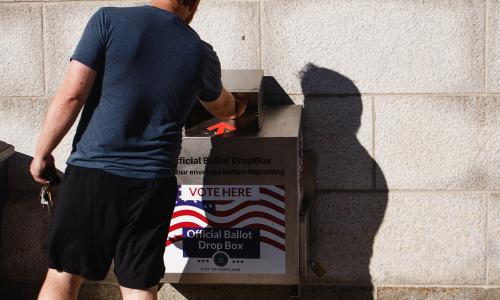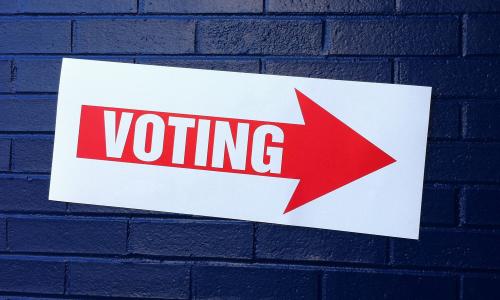Voting by mail has been part of US elections since long before any of us were born, dating back to the Civil War. For generations, voters unable to go to the polls on Election Day have used the mailbox to cast their vote and exercise their right to participate in our democracy.
In 2020, vote-by-mail became a subject of debate, as some elected officials questioned its reliability, legitimacy, and security. These objections came in the context of an expected surge in mail-in voting due to health and safety concerns arising from the COVID-19 pandemic. The following explainer was presented to counter misinformation about mail-in-voting with evidence-based information.
The importance of mail-in voting
Mail ballots are a crucial tool in ensuring that the right to vote is available to all eligible voters. While many people find the ritual of in-person voting convenient and meaningful, there have always been voters who find it difficult or impossible to vote this way – including people temporarily living far from where they are registered to vote, such as service members, or people who are unable to travel to a polling place. Mail-in voting allows them to participate in our democracy on the same footing as other eligible voters.
In 2020, far more people than usual are likely to vote by mail, for multiple reasons. First, the COVID-19 pandemic has created new risks for in-person voters. While masks and social distancing rules can help make polling places safer, many people—particularly those with risk factors such as age or chronic illness—may be reluctant to vote in person under these circumstances.
COVID-19 has also created capacity problems for in-person voting, as many states face a shortage of poll workers—a role traditionally filled largely by seniors, who are most at risk of serious illness and death from COVID-19. As a result, the number of polling places was drastically reduced in some state elections this summer. Fewer polling places means a longer trip for more voters—which disproportionately impacts Black, Latinx, and Indigenous voters and others who may lack access to transportation. It also means longer, more dangerous wait times when they arrive. Mail-in voting helps mitigate some of these problems (though it does not remove all barriers that some groups face).
How mail-in voting works
The exact rules and procedures for mail-in voting vary from state to state. Several states now conduct all voting by mail. Others permit mail-in voting only for voters who meet specific criteria, while still others allow any eligible voter to vote by mail (also known as “no-excuse” absentee voting). Some states provide mail-in ballots to all registered voters, while in other states, voters must request a ballot. Several states have modified or relaxed their mail-in voting rules for 2020 in response to fears about the health risks of in-person voting during the COVID-19 pandemic.
When ballots have been filled out, signed, and witnessed (in some states), voters return them, which can be done either through the United States Postal Service or via dedicated drop boxes. Incoming ballots are verified through a series of security checks, which again vary from state to state. Signatures and identifying information such as birth dates and Social Security numbers may be checked against voter registration records. Ballots may even be marked with bar codes that identify them with a specific voter.
If a ballot fails any of these security checks, it is not counted. In some states, voters with rejected ballots are given the opportunity to fix or “cure” their ballot, if time permits. Some states provide online verification systems so voters can track the status of a ballot from when it is mailed to when it is processed and counted.
States also differ in their deadlines for receiving mail-in ballots—some states only count ballots received by Election Day, while others allow ballots postmarked by Election Day—and in their timelines for counting mail ballots. Some states count mail-in ballots as they arrive, while others wait until after the polls close on Election Day.
We know mail-in voting is reliable
This year, there have been allegations and disinformation claiming that mail-in voting is inherently vulnerable to fraud, and that its impact on the election is therefore suspect. Is there any basis in fact for these claims? (Spoiler alert: there isn’t.)
One way to answer that question is to look at Oregon, which has been running mail-in only state elections for two decades now. You might wonder why you’ve missed all the media exposés of rampant voter fraud in the Beaver State. The reason is that there’s been nothing to expose—voter fraud cases in Oregon have constituted about 0.00001 percent of votes cast since 2000. In fact, mail-in voter fraud, like voter fraud in general, is exceedingly rare. US voters are more likely to be struck by lightning than they are to commit voter fraud.
A more legitimate concern is how well mail-in voting will be managed in 2020, particularly in states where far more people will be voting this way than ever before. A surge in mail-in voting poses organizational and technological challenges that could lead to higher than normal ballot rejection rates. Experts from UCS and other voting rights organizations will be monitoring the process closely to highlight problems in states that struggle to meet these challenges.
How mail-in voting will change the 2020 election
Election Day typically plays out according to a familiar script: most voting is done in person, and as the polls close in each state, information about the vote count gradually accumulates. When enough ballots have been counted that an Electoral College victory can be confidently determined for one candidate, that candidate is “called” as the winner, and the other candidates (usually) concede the election. This can all happen on Election Night because the vast majority of votes are cast in person and tallied immediately.
2020 will be different. A large number of ballots will be cast by mail, even in states where mail voting has been uncommon in the past. In some states, the counting of mail ballots won’t begin until the polls have closed. Counting mail-in ballots is a time-consuming process. It will be days—perhaps even weeks—before they are all counted. And in 2020, unlike a typical year, election results are likely to hinge on mail-in ballots in many states.
For this reason, we may not know who won the election for some time after election night. And in some states, mail-in ballots may shift election results, with a candidate who appeared to be ahead on election night falling behind as mail-in ballots are counted. It’s important to understand that such shifts are expected, and not to mistake them for evidence of something going wrong.
Media outlets may be tempted to call a winner on Election Night, because that’s their normal practice and many viewers will be expecting it. But it’s very important that they show restraint, calling the election only when enough of the ballots have been counted to provide certainty about the result—no matter how long that takes.




